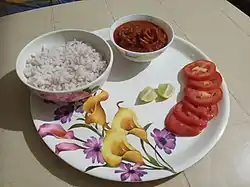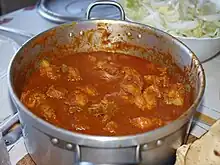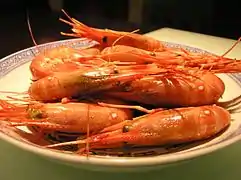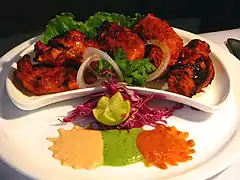Balchão
Balchão is an Indian dish (more specifically Goan) consisting of prawns, fish or pork in a spicy vinegar-based sauce.
 Goan calamari balchao with parboiled rice | |
| Alternative names | Balichão |
|---|---|
| Type | Sauce |
| Place of origin | India |
| Region or state | Goa |
| Main ingredients | Fish, prawns, or pork |
Ingredients
Balchão is a method of cooking, made with either fish (de peixe), prawns (de camarão), or pork (de porco), in a spicy and sour tomato-chili sauce.[1] It resembles pickling and can be made days in advance without reheating.[2]
Traditional balchão uses a paste made from dried shrimp known as galmbo in Konkani. Its otheringredients could include prawns, oil, onions chopped fine, tomatoes, garlic paste or cloves, ginger paste or ginger, dried red chillies, cumin seed, mustard seeds, cinnamon, cloves, sugar, vinegar and salt.[2]
Preparation
The prawns are cleaned and deveined then salted and set aside. The spices are roasted and cooled. Ginger, garlic and roasted spices are ground into a paste with the vinegar. Oil is heated, the prawns are added and fried until opaque. Next, the pan is used to fry onions. Once onions are light brown, tomatoes are added and fried till soft. Spice-vinegar paste is added, with sugar and salt. This is fried until the oil begins to separate from the masala, prawns are added, and the combination is cooked a few more minutes.[2]
Balchão is usually served with plain hot boiled rice. It keeps well under refrigeration.
History
Balchão was introduced to India by the Portuguese during Portuguese Goa, most likely from Malacca (today Melaka).
Preparation

Goan Catholic homes traditionally use coconut vinegar for its acidic sharpness. It is now common to use white vinegar or malt vinegar when coconut vinegar is not available.
See also
- Balichão, a related dish in Macau
- Indian cuisine
- List of pork dishes
- List of seafood dishes
 Food portal
Food portal
References
- Amelia Thomas; Amy Karafin (1 October 2009). Goa and Mumbai. Lonely Planet. pp. 60–. ISBN 978-1-74104-894-0. Retrieved 14 August 2012.
- "Pickle Style Dry Goan Prawns". The Spruce Eats. Retrieved 17 October 2018.



